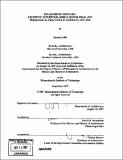Kinaesthetic impulses : aesthetic experience, bodily knowledge, and pedagogical practices in Germany, 1871-1918
Author(s)
Çelik, Zeynep, Ph. D. Massachusetts Institute of Technology
DownloadFull printable version (53.62Mb)
Other Contributors
Massachusetts Institute of Technology. Dept. of Architecture.
Advisor
Mark M. Jarzombek.
Terms of use
Metadata
Show full item recordAbstract
This dissertation studies a moment of transition in German aesthetics in the late nineteenth century. Starting in the 1870s, groups of artists, architects, historians, critics, connoisseurs, and museum officials in Germany declared that traditional aesthetics, which had operated "from above" with metaphysical concepts such as the beautiful and the sublime, was obsolete. According to these intellectuals, the old aesthetics needed to be replaced by a scientific and empirical "aesthetics from below." The emergence of the new aesthetics was closely related to the rise of mass politics and mass culture in the newly unified Germany. Concerned that an attentive and contemplative perception could not be afforded by the masses, these liberal-minded members of the educated middle classes theorized a new kind of aesthetic experience that was based on corporeal pleasure rather than intellectual judgment. According to this model, an aesthetic encounter with an artwork was primarily kinaesthetic: an artwork elicited an unconscious and immediate effect on the musculature of its beholder. I examine three episodes, in which this idea was employed to pedagogical ends at the turn of the twentieth century. In the work of the artist Hermann Obrist (1862-1927), the kinaesthetic model of experience became the basis of a new pedagogy for the arts, which utilized the unconscious movements of the body to choreograph the production and reception of aesthetic effects. The architect August Endell (1871-1925) theorized these effects further and attempted to invent an exact science of design, which correlated architectural forms to the reaction that they would produce in the human body. (cont.) The same idea of kinaesthetic response appeared within art historical circles under the rubric of the Baroque at the turn of the twentieth century, particularly in the debates between Heinrich Wilfflin (1864-1945) and August Schmarsow (1853-1936) on the nature of the painterly (malerisch). The double slide lecture was an ingenious solution devised by the incipient discipline of modern art history simultaneously to utilize the pedagogical effectiveness of kinaesthetic experience and to control its sensual excess.
Description
Thesis (Ph. D.)--Massachusetts Institute of Technology, Dept. of Architecture, 2007. Includes bibliographical references (p. 239-276).
Date issued
2007Department
Massachusetts Institute of Technology. Department of ArchitecturePublisher
Massachusetts Institute of Technology
Keywords
Architecture.